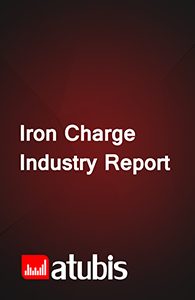UAE’s Iron Ore Pellet Market Outlook Report
9,694€
- TRY: 475,000 ₺
Iron ore pellets generally fall into two categories: direct reduction grade, and blast furnace grade. Direct reduction pellets are mostly used in the production of DRI and usually have higher grades and premiums, while blast furnace pellets are used in blast furnaces and generally have lower premiums. Since the United Arab Emirates does not have any blast furnaces to produce crude steel, all demand for iron ore pellets is DRI-grade.
Product Description
With a per-capita GDP of $61,000 in 2019, the UAE was the second largest economy in the region that year, behind Qatar. Despite being the most diverse economy in the Gulf Cooperation Council (GCC), the country is still reliant on oil. Oil and petrochemicals account for a major portion (more than half) of the country’s exports. Gold, diamond, and pearl (as jewelry) account for a quarter of exports from the country. With a history of over 20 years in the UAE, the iron and steel industry accounts for 2% of the country’s exports. Downstream iron and steel products constitute the major share of exports in the industry.
Market drivers of the UAE’s iron ore pellet
Lower grades at iron ore mines around the world and the requirement of crushing iron ore into fines in order to remove deleterious elements will present an opportunity for the UAE’s iron ore pellet market; many are forecasting a much faster growth rate for iron ore pellets compared to fines.
Abundant availability of natural gas, one of the major consumables in the production of sponge iron, as well as its green nature will be a strong driver of the sponge iron market and consequently iron ore pellets in the Persian Gulf region.
The UAE reported its first case of Covid-19 in February 2020. Not much longer, in March, social distancing and lockdowns were implemented. As a result, the country’s mobility index dropped to around 60%. As the pandemic continued to spread, lockdowns were extended into mid-April, but activities were gradually resumed under certain protocols. The country is now past the first wave of Covid-19, but many are still forecasting worse to come in the coming months. Thus, lockdowns are expected to continue, albeit temporarily, disrupting industrial performance and eventually lead to a decline in the country’s demand for iron and steel.
Overview of the UAE’s iron ore pellet market
A major portion of the UAE’s demand for iron ore pellets is met via imports; Oman has always been one of the largest import sources. Due to the production of sponge iron, there is strong demand for iron ore pellets; at the same time, there are many large buyers competing on the regional market, intensifying competition in the UAE as a result. This can drive pelletizing capacity development in the country as well as other upstream products relative to iron ore pellets. However, long term contracts by steelmakers with pellet suppliers will largely impede the development of pelletizing capacities. Therefore, the country is expected to remain a net importer. Given the surge in the UAE’s iron ore pellet demand, net imports are expected to remain around the same levels as the recent years.
Key players in the UAE’s iron ore pellet market
- Emirates Steel Industries P.J.S.C.
- Al Nasser Industrial Enterprises LLC
Additional Information
| Industry | Iron Ore Pellet |
|---|---|
| Region | United Arab Emirates |
| Report Type | Industry Report |
Specifications
| Report Attribute | Details |
| The base year for estimation | 2019 |
| Historical data | 2009-2018 |
| Forecast period | 2020-2025 |
| Quantitative units | Value in USD and Volume in Tonne |
| Report coverage | Market Overview, Dynamics, Market Outlook, Risks to Forecast, Consumer Market, Industry Overview, Market Landscape, Competitive Landscape, Market Attractiveness, External Macro Environment Analysis |
| Segments covered | Source, Composition, Type, Application |
| Pricing and purchase options | Please explore our purchase options to meet your exact research needs. |
Reasons to Buy
- Recognize the geographical distribution of import demand
- Identify the current and future key players of the trading market
- Achieve a better insight on potential target markets
- Understand the behavior of major suppliers/customers either globally or regionally
- Identify competitors as a feed for market analysis
Table of Content
- Executive summary
- Introduction
- Objective
- Market under study
- Product
- Product specifications
- Consumption structure
- Applications
- Physical properties
- Subjects discussed
- Geographical scope under study
- Study timeframe
- Study currency
- Potential audience
- Market dynamics
- Market drivers
- Restraints
- Opportunities
- Challenges
- Market overview
- Market size
- Industry capacities
- Existing capacities
- Capacity distribution
- Geographical distribution of capacities
- Future capacities
- Existing capacities
- Output
- Output trends
- Operating rates
- Consumption
- Consumption trend
- Consumption Share of domestic product
- Trade
- Exports
- Imports
- Trade balance
- Market balance
- Market breakdown by product type
- Market breakdown by product type
- Market breakdown by application
- Inventory
- Producers inventory
- Consumers inventory
- Traders inventory
- Market outlook
- Market factors
- Raw materials
- Costs and prices
- Competition
- The government
- Other factors
- Future scenarios
- Risks to forecast
- Market factors
- Consumer markets
- End-user markets
- Building construction
- Infrastructure construction
- Transportation manufacturing
- Industrial equipment manufacturing
- Durable goods manufacturing
- Consumable goods manufacturing
- Direct consumer markets
- Major Direct consumers
- Existing capacities
- Drivers
- Major Direct consumers
- End-user markets
- Export potentials
- Destinations
- Trade and insurance costs
- Import market suppliers
- Producers potential share
- Destinations
- Industry overview
- Raw materials
- The supply volume of raw materials
- Supply channels of raw materials
- Raw materials procurement costs
- Cost structure of producers
- Production cost curve
- Industry value added
- Generated new scrap
- Technology
- Raw materials
- Market landscape
- Domestic sales markets
- Pricing in the domestic market
- Potential domestic demand
- Trade agreements for imports
- Foreign suppliers
- Foreign sales market
- Prices
- Potential markets overview
- Trade agreements for exports
- Foreign customers
- Domestic sales markets
- Competitive landscape
- Producers
- Company profile
- Revenue structure
- Gross profit margins
- Capacity, output and sales
- Consumers
- Company profile
- Revenue structure
- Gross profit margins
- Capacity, output and sales
- Producers
- Market attractiveness
- Industry rivalry
- Threat of new entrants
- Threat of substitutes
- Bargaining power of buyers
- Bargaining power of suppliers
- Conclusion of Porter analysis
- PESTEL analysis
- Political factors
- Economic factors
- Social factors
- Technology factors
- Environmental factors
- Legal factors
- SWOT analysis
- Large-scale companies with favorable conditions
- Short-term strategies
- Long-term strategies
- Large-scale companies with unfavorable conditions
- Short-term strategies
- Long-term strategies
- Small enterprises with favorable conditions
- Short-term strategies
- Long-term strategies
- Small enterprises with unfavorable conditions
- Short-term strategies
- Long-term strategies
- Large-scale companies with favorable conditions
List of Figures
- Output and consumption; 2009-2019
- Market share of product applications; 2019
- Market surplus; 2019-2025
- Production process flowchart
- Market size; 2009-2025
- Existing capacity; 2009-2019
- Capacity distribution; 2019
- Geographic distribution of capacities; 2019
- Development of future capacity; 2009-2025
- Amount of output; 2009-2025
- Operating rates of production plants; 2009-2025
- Amount of consumption; 2009-2025
- Consumption share of domestic product; 2009-2025
- Exports of product; 2009-2019
- Imports of product; 2009-2019
- Historical trade balance; 2009-2019
- Future Market balance; 2020-2025
- Market output breakdown by alloy type; 2009-2025
- Market consumption breakdown by alloy type; 2009-2025
- Market balance breakdown by alloy type; 2009-2025
- Market output breakdown by product type; 2009-2025
- Market consumption breakdown by product type; 2009-2025
- Market balance breakdown by product type; 2009-2025
- Market consumption breakdown by application; 2009-2025
- Inventories of raw materials and products at producers factories; 2009-2019
- Consumers’ inventory of product; 2009-2019
- Traders’ inventory; 2009-2019
- Production forecast, according to raw materials and sales analysis; 2019-2025
- Market surplus; 2019-2025
- The share of end-user industries in the consumption; 2009 and 2019
- Changes in the end-consumption of extrusion products; 2019 vs 2025
- Applications in building construction industry; 2019
- Applications in infrastructure construction industry; 2019
- Applications in transportation manufacturing industry; 2019
- Applications in industrial equipment manufacturing industry; 2019
- Applications in durable goods manufacturing industry; 2019
- Applications in consumable goods manufacturing industry; 2019
- Capacity distribution structure of direct consumers; 2019
- Existing capacities of direct consumers in each province; 2019
- Suppliers of the export potential destination; 2019
- Historical exports to the export potential destination and future potential; 2016-2025
- Up-stream domestic supply; 2009-2019
- Raw materials domestic supply; 2009-2019
- Supply channels of producer plants
- Spot price of raw material in the market; 2009-2025
- Cash cost structure for production the product; 2019
- Production cost curve of the plants; 2019
- Gross value added of the industry; 2009-2019
- Generated new scrap; 2009-2019
- Sales channels
- Realized price of the product in the market; 2009-2025
- Potential demand of each province; 2019
- The main foreign suppliers to the market; 2009-2019
- FOB price vs domestic market; 2009-2025
- Map of global major importers > 20,000t; 2019
- Major foreign customers; 2009-2019
- Revenue structure of the producers; FY2019
- Sales income and gross profit margin of the producers; FY2009-2019
- Output and sales of the producers; FY2009-2019
- Revenue structure of the consumers; FY2019
- Sales income and gross profit margin of the consumers; FY2009-2019
- Output and sales of the consumers; FY2009-2019
- SWOT matrix for large-scale companies with favorable conditions
- Strategies positioning for large-scale companies with favorable conditions
- SWOT matrix for large-scale companies with unfavorable conditions
- Strategies positioning for large-scale companies with unfavorable conditions
- SWOT matrix for small enterprises with favorable conditions
- Strategies positioning for small enterprises with favorable conditions
- SWOT matrix for small enterprises with unfavorable conditions
- Strategies positioning for small enterprises with unfavorable conditions


